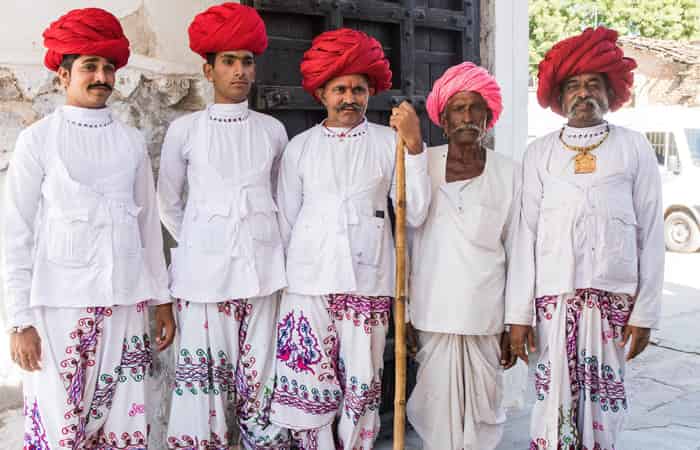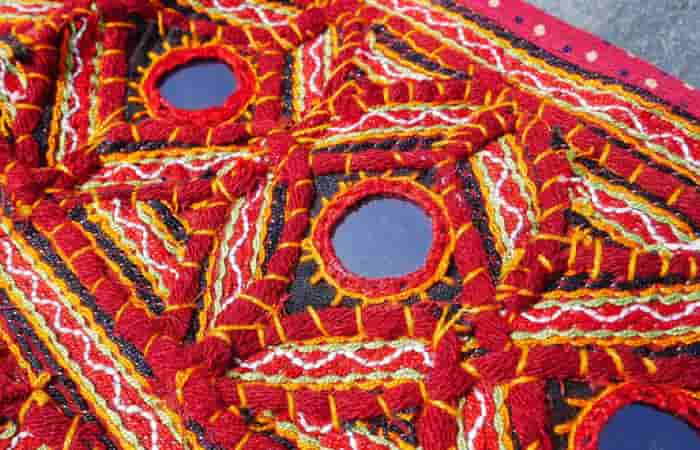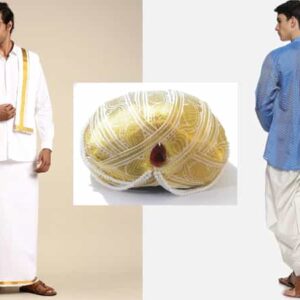The state of Gujarat in western India is known for its colorful festivals, its mouthwatering cuisine, its wonderful art and crafts and definitely for its many traditional costumes. The costumes worn by the Gujarati men and women are pretty unique. These traditional dresses come to reflect the state’s cultural heritage most aptly. As the state is inhabited by many ethnic groups, a unique type of diversity in costumes can easily be noticed.
The charm of traditional Gujarati dresses can ideally be understood at the time of the major festivals in the state like Navaratri, Dussehra and Janmashtami. During the festive times, the people of the state don their finest traditional dresses and celebrate to their heart’s content. Vibrant costumes worn by the Gujaratis actually set the mood for celebration. Traditional dresses teamed up with traditional jewelries and other accessories impart an aesthetic appeal to the overall getup of the natives of Gujarat. If you are interested in learning about the traditional dress of Gujarat, read the article below:
Key features of Gujarati Costumes
- Vibrantly colored dresses
- Dresses having intricate embellishments like mirror work, beadwork and stonework
- Stunning embroideries done with silvery and golden zari threads
- Multiple fascinating embroidery styles like the Rabari, Banni, Bavalia used to adorn the costumes
- Bandhani and Bandhej work showcased through the costumes
- Mind-blowing designs and patterns such as the floral pattern, figurative pattern and geometric pattern displayed on the dresses.
Traditional Dress of Gujarati Men

These are the various clothing worn by Gujarati men to complete their traditional look:
Chrono
This is an absolutely comfortable wide kind of trouser that is beautifully stitched in dhoti style. It is made out of soft fabric and is worn by the Gujaratis during festivals. It generally comes with a string for tying at one’s waist or is fitted with elastic. Chorno is ideal for the excessive summer heat that the state experiences. At the ankles, the trouser is tied loosely. This type of garment for the lower body is actually inspired by the styles of Iraq that were introduced to Gujarat through the traders coming from Iraq around the seventh century.
Kediyu
This is a typical Gujarati kurta which comes with frills. The kurta is a flowy-type Kurta also referred to as the Angrakha. The Kediyu resembles the look of a frock but in the top version. The frills on the Kediyu start from the chest and reach down to the level of the waist.
Dhoti
Dhoti, a kind of waistcloth to clad the legs is common Gujarati attire. It is a highly comfy wear made of cotton. Wearing the dhoti and carrying it well is a tricky matter but Gujarati men have developed these skills very well. The dhoti is worn by wrapping around one’s waist and is tucked by making it pass between the man’s legs.
Kurta
We all know about Kurta. It is a common Indian men’s attire for the upper body. Gujarati men wear kurtas in their daily life. For special occasions, kurtas they wear show gorgeous patterns and are made of silk. Regular-wear kurtas are usually made of cotton.
Shirts
Colorful shirts with patterns that are festival-themed are much liked by the Gujarati menfolk and they sport it on all occasions. These shirts are also differently referred to as Peharan or Kafani.
Phento
Phento is a typical Gujarati turban. In rural parts of Gujarat, men make sure to wear this headgear. It is usually made out of Bandhani cloth. The Phento is worn in a typical layered style.
Traditional Dress of Gujarati Women

These are the various clothing worn by Gujarati women to complete their traditional look:
Chaniyo
Chaniyo is the long skirt or petticoat-like clothing that is worn by Gujarati women in combination with the choli (top/blouse) & chunari (veil). The Chaniyo is a famous Gujarati traditional garb and generally comes in a vast array of vibrant and contrasting colors. Mind-blowing beadwork, mirror work and stone work usually deck the Chaniyo. The other name for Chaniyo is ghagra.
Choli
Choli is the blouse that is worn by women of Gujarat in combination with the Chaniyo. This bodice-like clothing for the upper body is usually cut short in order to expose a bare midriff. The other name for Choli is ‘Polku’. It is mostly adorned with attractive embroideries.
Chunari
Chunari, is but the versatile dupatta that adds dignity as well as beauty to the traditional Gujarati attire. It is also known by other names such as ‘Chunni’ or ‘Odhni’. It can be used as a headgear or a stole. It is worn in a diagonal pattern by the women. Bandhani work or shimmering stonework generally adorns the Gujarati Chunari. It is worn along with the Chaniya-Choli to complete the outfit.
Saree
Saree is one of the most famed outfits for the Indian women. It is a long piece of unstitched cloth. It is worn by tucking its one end at the waist while the other end is allowed to fall over the woman’s shoulder as pallu. However, Gujarati women wear their sarees in a special style that’s totally culture-specific. They sport the pallu of the saree in front and that actually sets them apart.
Zhabo
This is a special type of kurta women wear along with the Chaniyo. It may be used by Gujarati women as a substitute for the choli.
Gujarati Wedding Dresses
Dressing up in traditional, ethnic attires is a very important part of Gujarati wedding rituals. The Gujarati brides wear two types of wedding sarees- the Panetar & the Gharchola. The Panetar bridal saree is a combination of white and red. The borders of these sarees are usually red and showcase bandhej work. The Gharchola saree is a bandhej saree in bright red very creatively crisscrossed with golden checks or squares. This saree can also be in green or maroon colors. The Gharchola saree is gifted to the newly wedded Gujarati bride by her mother-in-law. As per traditions, the bride must wear during her vidai; i.e. when she departs from her parental house after completion of the wedding. Heavy gold jewelries are worn to complete the bridal look of the woman. These days, the brides of Gujarat are incorporating bridal lehenga-choli during the wedding ceremonies. Also, it is now a trend to wear Panetar saree-inspired lehenga choli during the wedding. These lehenga cholis are white and red in colors.
The Gujarati groom dresses up in Dhoti-Kurta. The colors of their attire range from cream to lemon yellow to fawn. The groom wears a gold ring and chain made of gold to complete the look.
Gujarati Kutch region attire
The Kutch region of Gujarat showcases a different and unique dressing pattern. Kanjari and Abha are two major garments worn by the Kutchian women. Kanjari is a long blouse embroidered most intricately. Abha is a glossy choli studded with glass pieces. The Kutchian men wear silken dhoti, long-sleeved coat and embroidered jackets.
Gujarati Textile

The Gujarati textile comprises of three major components or features listed out as follows:
Embroidery- The craft of embroidery is quite developed in the state. For many decades embroidering has been a side profession for the nomadic tribes of Gujarat. This craft is highly popular among the various Gujarati communities. Communities such as that of the Sodha Rajputs, Mukka, Mutwa, Jats and Ahirs excel in this craft of embroidering. The most famed Gujarati embroidery styles include the Banni, the Bavalia and the Rabari. Intricate patterns made out of silvery and golden threads on Gujarati clothing enhance the beauty of the dresses.
Bandhej- The craft of Bandhej also known as Bandhni is quite famous throughout the country. The Khatri tribal community residing in Gujarat’s Kutch region excels in the craft of Bandhej. In the Surendranagar and Jamnagar districts of Gujarat too this stunning craft is practiced. The Bandhej craft involves the use of the unique tie-and-dye technique to make attractive patterns on cloth. The tie-and-dye technique consists in tying of the cloth at various points and then dipping it into dyes of different colors, followed by drying of the cloth.
Patola- The exquisite Patola silk craft that had originated in Southern India around the 7th century was brought to Gujarat’s Patan by Kumarpal, the king of the Solanki dynasty. Under Kumarpal’s patronage, the Patola silk craft became a huge success in Gujarat. Till date Patan happens to be one of the most important hubs of the craft, followed by Baroda. Patola craft involves the incorporation of the double-ikat method. Huge amount of visual skills and coordination is required to achieve the perfection and finesse that the Patola craft is known for. Figurative, floral and geometrical patterns are generally made on the various Patola products that the state boasts of.
How are things changing in Gujarat?
Under the impacts of modernity, things are changing in Gujarat. Nowadays, the men have started wearing kurta-pajama, formal shirt-trousers or jeans. Women too have started dressing up in modern, casual styles. They are now wearing salwar-kameezes, kurti-leggings and the like.
So, this is all about the traditional dress of Gujarat. If you plan to embark on a Gujarat tour, don’t forget to don the typical Gujarati attire at least once!



